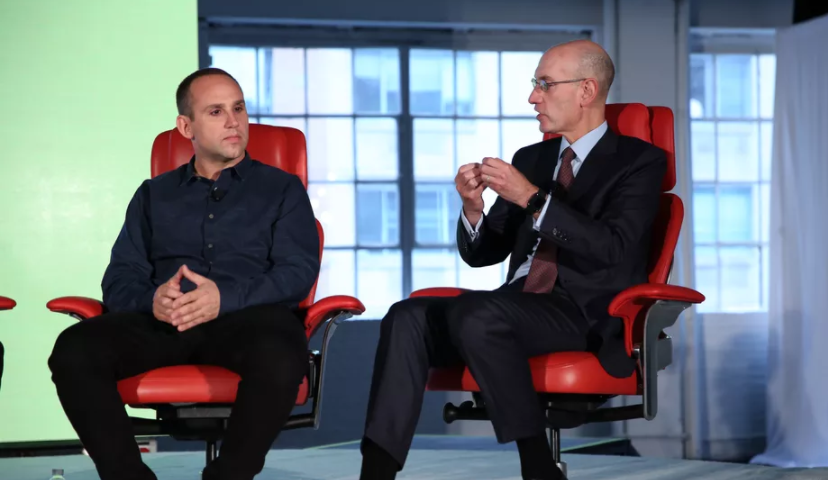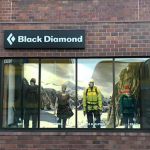Expanding internationally and capitalizing on its verticalization capabilities, Fanatics expects to reach over $2 billion in sales in 2017 and sees the long-term opportunity to reach more than $10 billion in sales, Michael Rubin, executive chairman of Fanatics, said Wednesday at Recode’s Code Commerce event.
Rubin was interviewed alongside NBA commissioner Adam Silver and the interview came as Fanatics this upcoming NBA season is taking over the license for NBA replica jerseys. Along with several other leagues, Fanatics manages e-commerce on NBA.com and also operates the NBA’s flagships store in Manhattan.
Rubin, who said Fanatics was generating only $250 million in revenues in 2010 when it was sold to eBay as part of the GSI Commerce acquisition, said a “huge portion” of the expected climb to $10 billion will come from expansion internationally, particularly tapping into the popularity of soccer.
But much of it is projected to stem from the ongoing benefits Fanatics gains in shifting to “v-commerce,” or becoming a vertical-commerce company able to produce its own merchandise to maximize sales online.
Beyond developing its own extensive internal manufacturing capacities, the shift was marked by Fanatics’ move earlier this year to acquire Majestic Athletic as well as recent deals to make fan gear with the NBA, MLB and NHL. Nike, Under Armour and Adidas, respectively, gained the rights to authentic players jerseys under those deals.
Rubin said online selling has evolved to be dominated by two “incredibly successful e-commerce companies”: Amazon and Alibaba. Combined, the two will generate about a trillion dollars in sales this year, he estimates. But Rubin added that “in a lot of ways they’re not that great for brands.”
He elaborated, “They don’t have a great brand presentation and in a lot of ways you can have kind of a flea market experience.”
By comparison, Fanatic’s partners are able to “control the presentation” in a “brand-right way.” With its v-commerce capabilities, Fanatics is also able to react quickly to trends.
Rubin referred to Fanatics’ approach as a “modern online version” of H&M, Zara or Uniqlo in its ability to speed hot product to fans while referring to Fanatics as the “first large-scale, v-commerce” company in extending the fast-fashion model online.
The success in the sports licensing game, according to Rubin, is still tied to quick response to “hot market” opportunities, such as a big win, an extraordinary feat or record by an athlete or major trade. Demand for team or player merchandise is strongest for such items when the moment happens and Fanatics’ v-commerce model is built to turn around orders within hours.
“A great example is Kyrie Irving’s trade to the Celtics,” said Rubin. “In the old days it would take weeks to get those jerseys to retail. Now in hours, since we’re completely vertical, we can best service fans.”
Silver said the NBA in the past had deals with Foot Locker and Amazon but he believes Fanatics is the only company that has built the scale and expertise to properly react to hot market opportunities.
“Michael had a vision as to where this business was going and I think if Nike and Adidas were sitting here, they would acknowledge that they couldn’t do what he’s doing even if they wanted to,” said Silver. “So Nike, beginning this year, they have our on-court apparel license for our uniforms. But when it comes to replica jerseys, they don’t have the infrastructure in place to deliver overnight.”
Overall, Rubin said the goal of the major sports leagues is to build their direct-to-consumer (DTC) businesses, whether through selling tickets directly or media as well as retail and e-commerce.
“It’s no different for any brand, whether Nike, Ralph Lauren, Under Armour or Adidas,” said Rubin. “Everyone’s very focused on building their direct-to-consumer business because they can create that relationship directly with the consumer and they can interact in a much better way.”
With the help of Fanatics, the leagues have grown their DTC businesses from one to two percent of overall merchandise sales ten years ago to more than 20 percent currently. Stated Rubin, “I would say collectively the leagues have one of the most successful direct-to-consumer businesses of any brands in the world and so many other industries and so many other companies aspire to have the kind of market share online the leagues are doing in partnership with us today.”
Beyond being able to better monetize fandom and engage with fans, direct-to-consumer provides the leagues with consumer data that can be used to support other areas such as ticket sales or given to teams for marketing purposes.
The next steps for Fanatics is creating a “very-modern, best-in-class, omnichannel experience” that involves partnerships with the venues where the games are being played. Rubin admits that the merchandising tie-in to the “live-experience” has been “pretty poor” in the past.
In conversations, Rubin said league partners say their goal in merchandising is “giving the consumer or the fan a chance to buy any way they want.” This may include the fan buying an item online and picking it up at the venue. It may include a fan buying an item at a venue and having it delivered to their seat or shipped to their house. Fanatics has partnerships with about 40 venues to support such omnichannel goals with many more expected to be rolled out out in the years ahead.
Silver noted that such capabilities such as one-hour delivery from Amazon in major cities likewise allows a fan to order gear while watching a game and receive it before the game is over.
Beyond omnichannel and speedy delivery, a big opportunity for fan apparel is tied to creating more engagement with viewers of the game.
Led by Facebook, Amazon and other Silicon Valley players, many tech companies are looking for “new ways to engage fans in these telecasts” and Silver suspects viewing sports games will look “very different” in three to five years.
Content, including greater information on players, is expected to a bigger part of broadcasts. But the content may also include information to support fantasy sports players or even gambling should it become legalized. With wearables, biometric information on players may become available, such as measuring stress levels when a player heads to the foul line. Instead of the standard play-by-play commentary, fans could hear commentary form one of theirs friends, a comedian or a celebrity. Replicating the feeling of sitting courtside, conversations between players and refs or players with other players may be heard.
Taking lessons from gaming sites such as Twitch and technologies such as virtual reality and augmented reality, interactivity has the potential to become a much bigger part of the sports-viewing experience. Incorporating the TV with social media and other devices such as iPads and mobile phones are also being explored.
Silver remarked that except for high-definition and being able to see games on mobile devices, the basic experience of watching sports games hasn’t changed in decades. Compared to the potential, Silver said, “It’s like watching a silent movie.”
To support its growth goals, Fanatics in August closed on an investment of $1 billion led by SoftBank Group’s Vision Fund. The NFL and MLB, both earlier investors, also participated in the round, which valued the company at $4.5 billion, sources told Reuters.
Rubin noted that Softback initially put $100 million into GSI Commerce when he started that business in 1999. GSI was sold to eBay in 2010 for $2.5 billion and Rubin reacquired the Fanatics part in 2011.
“Today, we’re over a $2 billion company,” said Rubin. “We aim this to be a $10 billion business globally. So building out all the infrastructure, globalizing the business, buying rights at a rapid pace, to keep adding capabilities – it takes capital.”
The full interview can be SEEN HERE.
Photo courtesy Recode
















